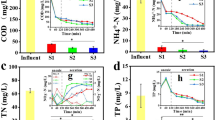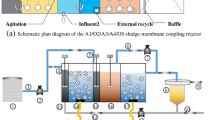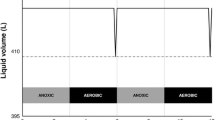Abstract
A laboratory-scale biodegradation and electron transfer based on the sulfur metabolism in the integrated (BESI®) process was used to treat a saline petrochemical nanofiltration concentrate (NFC). The integrated process consisted of activated sludge sulfate reduction (SR), and sulfide oxidation (SO) reactors, and a biofilm nitrification reactor. During the process, the total removal efficiencies of chemical oxygen demand (COD), ammonia nitrogen, and total nitrogen (TN) were 76.2, 83.8, and 73.1%, respectively. In the SR reactor, most of the organic degradation occurred and approximately 70% COD were removed by the sulfate-reducing bacteria (SRB). In the SO reactor, both the autotrophic and heterotrophic denitrifications were observed to take place. In parallel, batch experiments were conducted to detect the effects of different C/S and S/N ratios on COD removal and denitrification efficiency. The batch experiments were also conducted to detect the effects of salinity on COD and sulfate reduction. The composition of pollutants in the wastewater was complex, and some existing organics were not degraded by the SRB. The non-SRB groups also played important roles in the reactor. Under salinity-induced stress, the metabolisms of the SRBs and non-SRB groups were both inhibited. However, 6 g/L NaCl did not have much effect on the final COD removal efficiency. In the batch experiments, the added sulfide served as the electron donor for autotrophic denitrification. The added organics provided substance for heterotrophic denitrification.






Similar content being viewed by others
References
APHA (1998) Standard methods for the examination of water and wastewater (20th edition). American Public Health Association, Washington D C, USA
Brunet RC, Garcia Gil LJ (1996) Sulfide-induced dissimilatory nitrate reduction to ammonia in anaerobic freshwater sediments. FEMS Microbiol Ecol 21:131–138
Cardoso RB, Sierra-Alvarez R, Rowlette P, Flores ER, Gómez J, Field JA (2006) Sulfide oxidation under chemolithoautotrophic denitrifying conditions. Biotechnol Bioeng 95(6):1148–1157
Comstock SE, Boyer TH, Graf KC (2011) Treatment of nanofiltration and reverse osmosis concentrates: comparison of precipitative softening, coagulation, and anion exchange. Water Res 45(16):4855–4865
Dolejs P, Paclík L, Maca J, Pokorna D, Zabranska J, Bartacek J (2015) Effect of S/N ratio on sulfide removal by autotrophic denitrification. Appl Microbiol Biotechnol 99(5):2383–2392
Fajardo C, Mora M, Fernández I, Mosquera-Corral A, Campos JL, Méndez R (2014) Cross effect of temperature, pH and free ammonia on autotrophic denitrification process with sulphide as electron donor. Chemosphere 97:10–15
Fajardo C, Mosquera-Corral A, Campos JL, Méndez R (2012) Autotrophic denitrification with sulphide in a sequencing batch reactor. J Environ Manag 2012(113):552–556
Gatti MN, García-Usach F, Seco A, Ferrer J (2010) Wastewater COD characterization: analysis of respirometric and physical-chemical methods for determining biodegradable organic matter fractions. J Chem Technol Biotechnol 85:536–544
Greenlee LF, Lawler DF, Freeman BD, Marrot B, Moulin P (2009) Reverse osmosis desalination: water sources, technology, and today's challenges. Water Res 3(9):2317–2348
Hong JM, Li WB, Lin B, Zhan MC, Liu CD, Chen BY (2013) Deciphering the effect of salinity on the performance of submerged membrane bioreactor for aquaculture of bacterial community. Desalination 316:23–30
Kleerebezem R, Mendez R (2002) Utotrophic denitrification for combined hydrogen sulfide removal from biogas and post-denitrification. Water Sci Technol 5(10):349–356
Lens PNL, Visser A, Janssen AJH, Hulshoff Pol LH, Lettinga G (1998) Biotechnological treatment of sulfate-rich wastewaters. Crit Rev Env Sci Technol 28(1):41–88
Lens P, Vallero M, Esposito G, Zandvoort M (2002) Perspectives of sulfate reducing bioreactors in environmental biotechnology. Rev Environ Sci Biotechnol 1:311–325
Luptakova A, Kusnierova M (2005) Bioremediation of acid mine drainage contaminated by SRB. Hydrometallurgy 77(77):97–102
Martins M, Faleiro ML, Barros RJ, Veríssimo AR, Barreiros MA, Costa MC (2009) Characterization and activity studies of highly heavy metal resistant sulphate-reducing bacteria to be used in acid mine drainage decontamination. J Hazard Mater 166(2–3):706–713
Moraes BS, Souza TSO, Foresti E (2012) Effect of sulfide concentration on autotrophic denitrification from nitrate and nitrite in vertical fixed-bed reactors. Process Biochem 47(9):1395–1401
Muyzer G, Stams AJ (2008) The ecology and biotechnology of sulphate-reducing bacteria. Nat Rev Microbiol 6(6):441–454
Nederlof MM, Van Paassen JAM, Jong R (2005) Nanofiltration concentrate disposal: experiences in The Netherlands. Desalination 178(1):303–312
Oh SE, Bum MS, Yoo YB, Zubair A, Kim IS (2003) Nitrate removal by simultaneous sulfur utilizing autotrophic and heterotrophic denitrification under different organics and alkalinity conditions: batch experiments. Water Sci Technol 47(1):237–244
Qian J, Lu H, Cui Y, Wei L, Liu R, Chen GH (2015) Investigation on thiosulfate-involved organics and nitrogen removal by a sulfur cycle-based biological wastewater treatment process. Water Res 69:295–306
Sharma M, Jain P, Varanasi JL, Lal B, Rodríguez J, Lema JM, Sarma PM (2013) Enhanced performance of sulfate reducing bacteria based biocathode using stainless steel mesh on activated carbon fabric electrode. Bioresour Technol 150:172–180
Tam LS, Tang TW, Lau GN, Sharma KR, Chen GH (2007) A pilot study for wastewater reclamation and reuse with MBR/RO and MF/RO systems. Desalination 202:106–113
Vaiopoulou E, Melidis P, Aivasidis A (2005) Sulfide removal in wastewater from petrochemical industries by autotrophic denitrification. Water Res 39:4101–4109
Vallero MV, Hulshoff Pol LW, Lettinga G, Lens PN (2003) Effect of NaCl on thermophilic (55 degrees C) methanol degradation in sulfate reducing granular sludge reactors. Water Res 37(10):2269–2280
van den Bosch PL, van Beusekom OC, Buisman CJ, Janssen AJ (2007) Sulfide oxidation at halo- alkaline conditions in a fed-batch bioreactor. Bitechnol Bioeng 7(5):1053–1063
van den Brand TPH, Roest K, Chen GH, Brdjanovi D, van loosdrecht MCM (2014) Long-term effect of seawater on sulphate reduction in wastewater treatment. Environ Eng Sci 32: 622–630
van den Brand TPH, Roest K, Chen GH, Brdjanovic D, van Loosdrecht MCM (2015) Effects of chemical oxygen demand, nutrients and salinity on sulfate-reducing bacteria. Environ Eng Sci 32(10):858–864
Van der Bruggen B, Lejon L, Vandecasteele C (2003) Reuse, treatment, and discharge of the concentrate of pressure driven membrane processes. Environ Sci Technol 37(17):3733–3738
Venzlaff H, Enning D, Srinivasan J, Mayrhofer KJJ, Hassel AW, Widdel F, Stratmann M (2013) Accelerated cathodic reaction in microbial corrosion of iron due to direct electron uptake by sulfate-reducing bacteria. Corros Sci 66:88–96
Wang J, Shi M, Lu H, Wu D, Shao MF, Zhang T, Ekama GA, van Loosdrecht MCM, Chen GH (2011) Microbial community of sulfate-reducing up-flow sludge bed in the SANI® process for saline sewage treatment. Appl Microbiol Biotechnol 90:2015–2025
Wei C, He W, Wei L, Li C, Wei D, Ma J (2016) The analysis of microbial community in the biodegradation, electron transfer based on sulfur metabolism integrated (BESI®) process for reverse osmosis concentrate (ROC) treatment by 454 pyrosequencing. Desalin Water Treat 57(60):29303–29315
Wong BT, Lee DJ (2011) Denitrifying sulfide removal and carbon methanogenesis in a mesophilic, methanogenic culture. Bioresour Technol 102(12):6673–6679
Wu C, Zhou Y, Sun Q, Fu L, Xi H, Yu Y, Yu R (2016) Appling hydrolysis acidification-anoxic-oxic process in the treatment of petrochemical wastewater: from bench scale reactor to full scale wastewater treatment plant. J Hazard Mater 309:185–191
Wu C, Zhou Y, Wang P, Guo S (2015) Improving hydrolysis acidification by limited aeration in the pretreatment of petrochemical wastewater. Bioresour Technol 194:256–262
Acknowledgements
This work was supported by the Funds for Creative Research Groups of China (No. 51121062) and State Key Laboratory of Urban Water Resource and Environment (Harbin Institute of Technology) (No. 2015TS07 and No. HC201621-02).
Author information
Authors and Affiliations
Corresponding author
Additional information
Responsible editor: Gerald Thouand
Electronic supplementary material
Fig. S1
(DOC 949 kb)
Rights and permissions
About this article
Cite this article
Wei, C., Wei, L., Li, C. et al. Effects of salinity, C/S ratio, S/N ratio on the BESI process, and treatment of nanofiltration concentrate. Environ Sci Pollut Res 25, 5129–5139 (2018). https://doi.org/10.1007/s11356-017-9585-1
Received:
Accepted:
Published:
Issue Date:
DOI: https://doi.org/10.1007/s11356-017-9585-1




